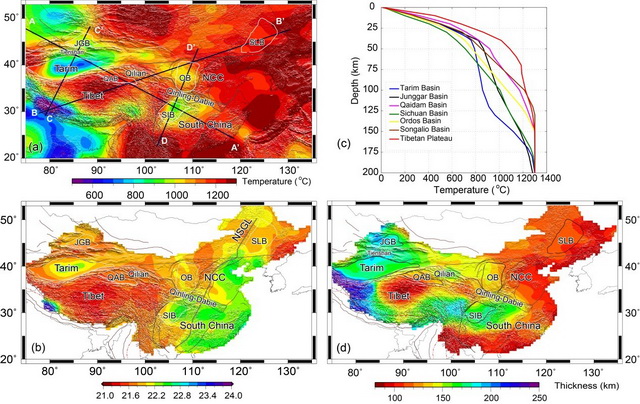The strength distribution in the continental lithosphere plays an essential role in controlling the behavior of continental deformation. And the viscosity is a more direct evidence for the flow, compared with the velocity and temperature.
The present tectonics of Mainland China has been mainly affected by the Indo-Asian continental collision in the southwest, and the subduction of the NW Pacific plate in the east. Therefore, this region is obviously a key natural laboratory to investigate the influence that strength variations have on the evolution of intraplate continental lithosphere. The previous studies on the lithospheric temperature follow into two approaches: (1) solving the steady state thermal conduction equation, formulated in one or two dimension using heat flow data and (2) inverting seismic velocity models using mineral physics constraints. The results obtained using the first approach, were influenced by the uneven distribution of the heat flow observations and only reflect the shallow crustal part. While the results from the latter are more sensitive to the deep part.
Recently, Dr. Yangfan Deng from Guangzhou Institute of Geochemistry, Chinese Academy of Science and Dr. Magdala Tesauro from Utrecht University present a new thermal model by integrating a previous crustal model using a 3-D steady state heat conduction equation, with estimates for the upper mantle thermal structure, obtained by inverting a S wave tomography model. The lithospheric thickness is estimated from the temperature isotherm, which is ~ 100 km in Eastern China. According to the geotherms in the main basins, we identify the Tarim as a cold basin and Songliao as a hot basin.
In view of the obscurity of rock compositions in the lithosphere, we construct two end-member lithospheric rheological models named soft and hard models to estimate the strength according to the Byerlee’s law and Power law creep. Tarim basin and Yangtze Craton have a strong upper mantle in both rheological models, corresponding to a jelly sandwich model. However, the strength in Tibetan Plateau, Qaidam and Junggar basins is localized only in the uppermost part of the crust, corresponding to crème brûlée model.
The effective viscosity is estimated according to the strength. We notice that in both rheological and viscosity models there is a sharp contrast between the tectonic features located west and east to the NSGL, which thus represents a lithospheric boundary. A comparison of temperatures, strength, and effective viscosity variations with earthquakes distribution and their seismic energy released indicates that both the deep part of the crust and the upper mantle of the Tibetan Plateau are weak and prone to flow toward adjacent areas. Our models do not support the flow from Tibet to the orogen between Ordos and Sichuan basin. Deep earthquakes occurred beneath Tien Shan and south Tibet may have the difference mechanism.
Financially support by the Strategic Priority Research Program (B) of the Chinese Academy of Sciences (XDB18030101) and the National Science Foundation of China (41504069), the study is published in Tectonics.
Deng, Y.*, and M. Tesauro (2016), Lithospheric strength variations in Mainland China: Tectonic implications, Tectonics, 35, 2313-2333 doi:10.1002/2016TC004272.

Figure (a) The temperature at 100 km depth; (b) Exponent of vertically averaged effective viscosity variations of the lithosphere, assuming a soft rheological model. (c) Average geotherms (°C) of some key tectonic structures; (d) Thickness of the thermal lithosphere corresponding to the depth of the 1250°C isotherm.